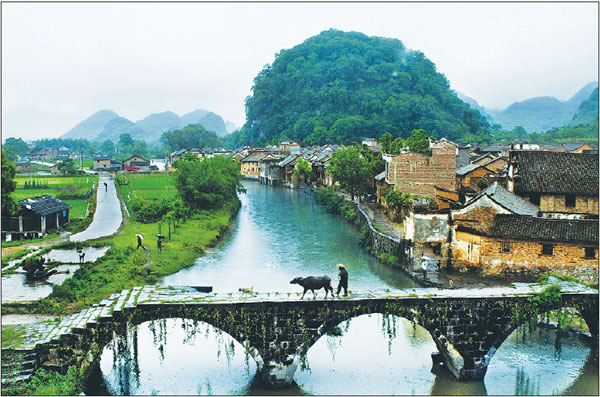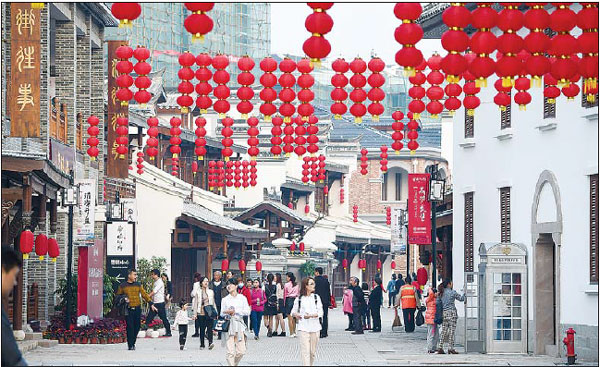Local Tourism To Benefit One And All
Hunan province will promote all-for-one tourism to support the development of the local tourism industry.
The concept of all-for-one tourism was mentioned by Premier Li Keqiang in the 2017 Government Work Report in March. The phrase describes the integrated development of tourism spanning all levels of industry, including rural tourism, industrial tourism, cultural tourism and the service industry.
In that report, Li called for improved tourism facilities and services, and for a big push to develop rural tourism, recreational tourism and all-for-one tourism.
Hunan reported strong growth in the tourism industry in the first quarter in 2017. As of the end of March, the province had received more than 14 million tourists, increasing 19.01 percent year-on-year. The overall income of the tourism industry in the first quarter was 114.8 billion yuan ($16.61 billion), rising 23.67 percent year-on-year.
Hunan is making a name for its abundant and unique tourism resources across China.
Chen Xianchun, director of Hunan Tourism Development Commission, said that Hunan has 122 counties. Among them, 70 are known for their tourism resources.
The province, in Central China, boasts both natural beauty and cultural heritage. Southern Hengshan Mountain in Hengyang city is one of the five most beautiful and renowned mountains in Chinese history. Yuelu Academy in Changsha served as an institute for higher education since its establishment in 976. The Fenghuang Ancient Town is known for buildings of the local Miao ethnic people.
"Hunan has unique advantages in developing all-for-one tourism because our counties have abundant, high-quality tourism resources," Chen said.
Hunan authorities have realized that a well-established public service system will play a vital role in supporting all-for-one tourism and vowed to to enhance the quality of public services.
"The all-for-one tourism model has many supporting elements. The most important one is public service," said Shang Bin, deputy director of the Hunan Tourism Development Commission. "A tourism city not only needs scenic spots, but also needs services such as sightseeing buses, information platforms and city advertising systems."
"A tourism site should not be developed like a city, but a city should be built like a tourism site," Shang added.
City authorities in Hunan have taken actions to strengthen supporting facilities' construction in tourism sites since 2016.
The administrator of Liangshan Mountain in Shaoyang city launched a toilet upgrade and development plan a few years ago. Now, visitors to the site can find well-equipped, well-maintained toilets.
The provincial government also planned many infrastructure upgrades to develop a comfortable tourism environment for travelers.
Hunan plans to build and extend 178 roads to better connect tourism spots with the outside world during the 13th Five-Year Plan (2016-20) period. The total length of the roads will be 1,351 kilometers upon completion.
Local governments' efforts
Regional authorities in Hunan spared no efforts in developing new tourism products and concepts aimed at strengthening competitiveness.
Luowen village in Yiyan has built a strong reputation in the tourism industry by focusing on developing graffiti culture.
The first International Graffiti Art Festival, held in early April, attracted 12 graffiti masters from seven countries including France, the United Kingdom, Denmark and South Korea.
Local authorities said the village has become a popular travel destination in Hunan since the festival.
Yongzhou city has decided to become a cultural tourism destination. The city obtained approvals from the State Council to be listed as a national-level historic heritage city at the end of 2016.
Tongdao Dong autonomous county in Huaihua city will support the Dawuliang Singing Festival to promote the integration of ethnic culture with the tourism industry.
Zhangjiajie, one of the leading tourism cities in Hunan, has achieved outstanding results in developing and promoting tourism products and innovation over the past few years. International events such as the Tianmen Mountain Drift Competition have strongly boosted the strength of the local tourism industry.
The Zhangjiajie Grand Canyon Glass Bridge, the longest and highest glass bridge in the world, opened in the second half of 2016. It has become a must-see scenic site for global travelers.
Great efforts have been made by the Zhangjiajie government to accelerate the region's internationalization. It has launched programs with 10 countries and regions including France, Thailand and Israel to strengthen international communication and cooperation this year.
Zhangjiajie signed a Trade and Tourism Cooperation Memorandum with Chonburi of Thailand at the end of March.
Officials from Thailand said that Zhangjiajie has become an important travel destination for Thailand's people. More than 50,000 Thai tourists visit the city per year.
Ouyang Bin, vice-mayor of Zhangjiajie, said that the city is one of the rarest geographical sights in the world and thus has many tourism resources.
Zhangjiajie is famous for its unique peaks, crystal clear streams, dense forests and large karst caves, according to Ouyang.
The Zhangjiajie National Forest Park became the first national forest park of China in 1982 and was listed as a UNESCO World Natural Heritage Site in 1992.
The city welcomed more than 61 million global tourists and reported 44.3 billion yuan in overall tourism income in 2016.
Looking ahead, Zhangjiajie plans to develop the first tourism destination with more than 100 million visitors in China in three years. Foreign visitors will account for 10 percent of the total amount and annual tourism income will reach 100 billion yuan.
fengzhiwei@chinadaily.com.cn
|
Hunan province has vowed to boost the development of the local tourism industry by promoting all-for-one tourism.Photos Provided To China Daily |
|
Changde River Street allows visitors to explore the beauty of local traditional culture.Photos By Luo Bing |
|
Left: The Dawuliang Singing Festival helps promote the integration of ethnic culture with the local tourism industry. Right: A memorandum of understanding on cooperation in economic, trade and tourism is singed between Zhangjiajie and Chonburi, Thailand, in March. Zhangjiajie party chief Guo Zhenggui (right) presents a gift to Vitaya Khunplome, chief executive of Chonburi, Thailand. |
(China Daily 05/06/2017 page10)

















